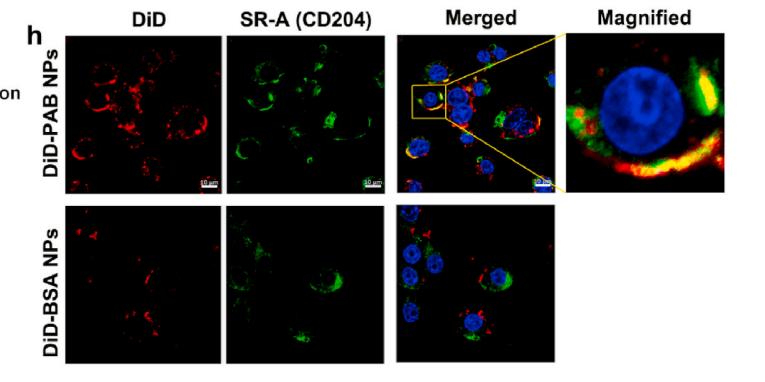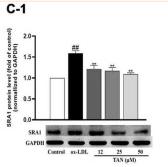MSR1 Antibody - #DF6694
| Product: | MSR1 Antibody |
| Catalog: | DF6694 |
| Description: | Rabbit polyclonal antibody to MSR1 |
| Application: | WB IHC IF/ICC |
| Cited expt.: | WB, IF/ICC |
| Reactivity: | Human, Mouse, Rat |
| Prediction: | Pig, Bovine, Horse, Sheep, Rabbit, Dog, Xenopus |
| Mol.Wt.: | 50-70kD; 50kD(Calculated). |
| Uniprot: | P21757 |
| RRID: | AB_2838656 |
Related Downloads
Protocols
Product Info
*The optimal dilutions should be determined by the end user. For optimal experimental results, antibody reuse is not recommended.
*Tips:
WB: For western blot detection of denatured protein samples. IHC: For immunohistochemical detection of paraffin sections (IHC-p) or frozen sections (IHC-f) of tissue samples. IF/ICC: For immunofluorescence detection of cell samples. ELISA(peptide): For ELISA detection of antigenic peptide.
Cite Format: Affinity Biosciences Cat# DF6694, RRID:AB_2838656.
Fold/Unfold
CD204; CD204 antigen; CD24; Macrophage acetylated LDL receptor I and II; Macrophage scavenger receptor 1; Macrophage scavenger receptor type III; Macrophage scavenger receptor types I and II; Msr 1; MSR1; MSRE_HUMAN; phSR1; phSR2; SCARA 1; SCARA1; Scavenger receptor class A member 1; Scavenger receptor class A, member 1; Scavenger receptor type A; Scvr; SR A; SRA;
Immunogens
A synthesized peptide derived from human MSR1, corresponding to a region within N-terminal amino acids.
Isoform I, isoform II and isoform III are expressed in monocyte-derived macrophages. Isoform I and isoform II are expressed in the liver, placenta and brain.
- P21757 MSRE_HUMAN:
- Protein BLAST With
- NCBI/
- ExPASy/
- Uniprot
MEQWDHFHNQQEDTDSCSESVKFDARSMTALLPPNPKNSPSLQEKLKSFKAALIALYLLVFAVLIPLIGIVAAQLLKWETKNCSVSSTNANDITQSLTGKGNDSEEEMRFQEVFMEHMSNMEKRIQHILDMEANLMDTEHFQNFSMTTDQRFNDILLQLSTLFSSVQGHGNAIDEISKSLISLNTTLLDLQLNIENLNGKIQENTFKQQEEISKLEERVYNVSAEIMAMKEEQVHLEQEIKGEVKVLNNITNDLRLKDWEHSQTLRNITLIQGPPGPPGEKGDRGPTGESGPRGFPGPIGPPGLKGDRGAIGFPGSRGLPGYAGRPGNSGPKGQKGEKGSGNTLTPFTKVRLVGGSGPHEGRVEILHSGQWGTICDDRWEVRVGQVVCRSLGYPGVQAVHKAAHFGQGTGPIWLNEVFCFGRESSIEECKIRQWGTRACSHSEDAGVTCTL
Predictions
Score>80(red) has high confidence and is suggested to be used for WB detection. *The prediction model is mainly based on the alignment of immunogen sequences, the results are for reference only, not as the basis of quality assurance.
High(score>80) Medium(80>score>50) Low(score<50) No confidence
Research Backgrounds
Membrane glycoproteins implicated in the pathologic deposition of cholesterol in arterial walls during atherogenesis. Two types of receptor subunits exist. These receptors mediate the endocytosis of a diverse group of macromolecules, including modified low density lipoproteins (LDL). Isoform III does not internalize acetylated LDL.
Membrane>Single-pass type II membrane protein.
Isoform I, isoform II and isoform III are expressed in monocyte-derived macrophages. Isoform I and isoform II are expressed in the liver, placenta and brain.
Research Fields
· Cellular Processes > Transport and catabolism > Phagosome. (View pathway)
References
Application: IF/ICC Species: Mouse Sample:
Application: IF/ICC Species: mouse Sample: Raw264.7 cells
Application: WB Species: Mice Sample: RAW264.7 cells
Restrictive clause
Affinity Biosciences tests all products strictly. Citations are provided as a resource for additional applications that have not been validated by Affinity Biosciences. Please choose the appropriate format for each application and consult Materials and Methods sections for additional details about the use of any product in these publications.
For Research Use Only.
Not for use in diagnostic or therapeutic procedures. Not for resale. Not for distribution without written consent. Affinity Biosciences will not be held responsible for patent infringement or other violations that may occur with the use of our products. Affinity Biosciences, Affinity Biosciences Logo and all other trademarks are the property of Affinity Biosciences LTD.





